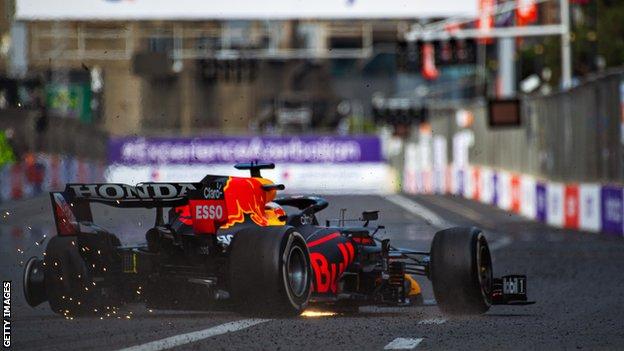
Pirelli says the two high-speed tyre failures at the Azerbaijan Grand Prix were caused by the way in which they were being run.
Red Bull’s Max Verstappen lost the race victory and Lance Stroll’s Aston Martin crashed out of fourth when their left rear tyres failed at close to 200mph.
Pirelli said an investigation found the tyres suffered “a circumferential break on the inner sidewall”.
It said this was “related to the running conditions of the tyre”.
This was despite the teams in question following the prescribed starting parameters for the tyres, Pirelli said.
Pirelli added: “The process established that there was no production or quality defect on any of the tyres; nor was there any sign of fatigue or delamination.”
The company’s statement said that it had submitted its report to governing body the FIA and the teams.
Pirelli and the FIA have subsequently agreed a new set of protocols governing tyre usage. These will come into force from this weekend’s French Grand Prix.
What does this mean?
Pirelli mandates a minimum starting pressure and a maximum starting temperature as a way of trying to control the conditions in which the tyres behave when the cars are on track.
The level of the minimum starting pressure is set as a means of controlling the structural integrity of the tyres. The higher the pressure, the less strain is put on the tyre’s sidewall, but raising the tyre pressures has an adverse effect on car cornering performance.
Pirelli sets the starting figure assuming the pressure will increase by a certain amount when the car is out on track. If the tyres run at a lower pressure than Pirelli intended, then they can be prone to failure because the company’s calculations as to what is a safe way of running the tyres will no longer apply.
The implication is that a number of teams have been finding clever and legal ways to limit the rise in tyre pressure when the car is running on track, despite following all the stipulated starting guidelines.
Pirelli will now set a minimum pressure for the tyres after running on track, and cars will be checked at random throughout the race weekend.
Red Bull said in a statement: “We have worked closely with Pirelli and the FIA during their investigation into Max’s tyre failure on lap 47 of the Azerbaijan Grand Prix and can confirm that no car fault was found. We adhered to Pirelli’s tyre parameters at all times and will continue to follow their guidance.”

